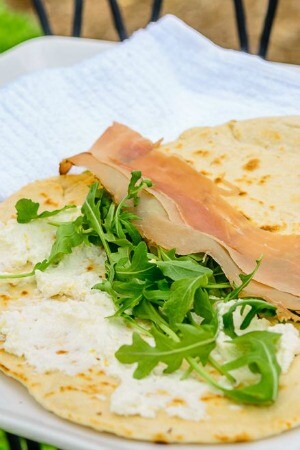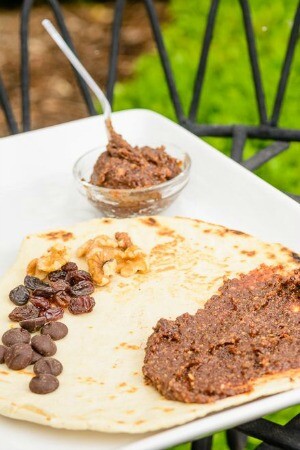Learning The History Of San Marino Through Food

Today, the city of San Marino is known for its wide boulevards, stately mansions and the amazing resource that is the Huntington Library. Given the rapid change and tumult that typifies most of Southern California, the peaceful streets of San Marino can seem nearly timeless. But that is, of course, not the case.
Indeed, the city of San Marino is celebrating its centennial this year. In recognition of this milestone, the Huntington Library has put together a special exhibition about the three families (Wilson, Patton and Shorb) that helped found the city. "Cultivating California: Founding Families of the San Marino Ranch" will be on display until May 13th. In addition to the exhibit, the Huntington has scheduled a number of related events including a cooking class for children that I taught, exploring the culture of historic San Marino, through food.

Why food? There are many ways that we can ingest culture; for example, art, science, literature, and music. But there is only one type of culture that we consume on a daily basis, often several times a day, and that is food culture. Furthermore, teaching history and culture though food encourages active learning and is living history, not just something that takes place in a museum but can be brought into home and kitchen and enjoyed time and again.
And, after all, before San Marino became a city in 1913, it was known as the San Marino Ranch, an agricultural community with orchards, vineyards and a winery. How better to learn about San Marino's history than to explore it through food? Which brings us to the class that I taught this past Sunday.

The city of San Marino itself is comprised primarily of part of a grant of land given to James de Barth Shorb by his father-in-law, Benjamin Davis "Don Benito" Wilson. Wilson was one of the early leaders and statesmen of California. Originally from Tennessee, he came to California as part of the Workman-Rowland Party in 1841, stopping here instead of continuing to travel to China as originally planned. He eventually became the second mayor of Los Angeles, a county supervisor, state senator (three terms) and was one of General George Patton's grandfathers. You probably know him best because Mt. Wilson is named after him.
But back to James de Barth Shorb, Wilson's son-in-law. After he received his grant of some 500 acres, he renamed the land "San Marino" after his grandfather's plantation in Maryland. The plantation in Maryland was itself named after the Most Serene Republic of San Marino, an enclaved city-state located within Italy and the third-smallest country in Europe, only a bit bigger than the Vatican or Monaco.
And thus, the first dish of the class, a flat bread traditional to Europe's San Marino that can be used with either sweet or savory toppings: The piada, sometimes called the piadina.
San Marino Piada
Makes four 7-inch Piade
2 Cups Flour
1 tsp Salt, Kosher
1 ¼ tsp Baking Powder
1/8 tsp Baking Soda
2 Tbsp Olive Oil, Extra Virgin
2/3 Cup Water

In a mixing bowl, whisk together the flour, baking powder, baking soda, and salt. Drizzle the olive oil into the flour mixture and mix gently with one hand. Once mixed, use the other hand to pour the water into dough and massage with both hands until a shaggy dough is formed. Do not worry if all the flour is not quite absorbed at this point.
Turn the dough out onto a flat surface and knead for 6-10 minutes, until it forms a soft and uniform ball. Alternatively, knead the dough in a standing mixer with a dough hook on low speed for 4-8 minutes.
Cover the dough and allow it to rest for 30 minutes. At this point it can be stored in plastic wrap in the refrigerator for 1-2 days. If refrigerated, allow dough to return to room temperature before continuing.
When ready to bake, transfer the dough to your flat work surface and divide it into 4 pieces and roll each piece into a ball. Using a rolling bin, roll each piece of dough out until approximately 7-inches in diameter and 1/8-inch thick.
Set a cast iron skillet, griddle or comal over high heat (approximately 425°F). When the pan is hot enough that droplets of water sizzle as soon as they hit the surface, begin cooking the piadas. Place the piadas on the hot pan. If the piada begins to puff up, prick with fork.
Cook for one minute on each side, or until you start seeing toasted brown spots all over the piada. Transfer the cooked piada to a clean dishtowel and cover with another dish towel to keep it warm. Continue preparing the rest of the piadas as described above.
Add toppings (optional) and eat immediately. They are best when served fresh, but may be kept for one day in a covered container.
Note: Piadas are sometimes made with lard, but olive oil is also common and they did grow olives on the San Marino Ranch.
But what to top the piada with? Anything that makes a good sandwich, like ham and gruyere, would likely work with a piada, but traditional toppings in the Republic of San Marino include such ingredients such as prosciutto, arugula and a soft, fresh cheese such as mozzarella, chevre or ricotta. Here's a ricotta recipe:
Eureka Lemon Ricotta
Makes 1 cup
3 ½ Cups Milk, Whole
½ Cup Cream, Whipping
½ tsp Salt, Kosher
1 Tbsp Zest, Eureka Lemon, Finely Minced (approximately 1-2 lemons)
3 Tbsp Juice, Eureka Lemon, Freshly Squeezed (approximately 1-2 lemons)
In a large (3-qt) nonreactive sauce pan combine the milk, cream and salt. Attach a candy or deep-fry thermometer. Over medium heat, bring the milk mixture to 190°F, stirring occasionally to ensure that the milk does not scorch.
Meanwhile, using a microplane grater zest the Eureka lemon and put 1 Tbsp zest aside. Juice the lemon and put aside 3 Tbsp of juice.
When the milk is 190°F, remove from the heat, add the lemon juice and zest, stir once or twice, slowly, cover and allow to sit undisturbed for 5 minutes.
Over a large bowl (to catch the whey), pour the resulting curds and whey into a jelly strainer or through a few layers of cheesecloth (or single layer of butter muslin) set in a colander. Allow to drain for at least an hour or two hours for firmer, thicker cheese.
Eat immediately, or transfer to an airtight container, refrigerate and eat within three days for best quality.
Note: Why Eureka lemons? They are the most common commercial lemon variety (and well they should be, as they're delicious, high quality and prolific). Their name is the same as the California State Motto -- "Eureka"! But, more importantly, for purposes of San Marino history, they were developed in the 1870s in Los Angeles and were likely grown on the San Marino Ranch. Moreover, one of the men responsible for their development was W.H. Workman, the nephew of William Workman, who was one of the leaders of the expedition that brought Benjamin Wilson to California in the first place. W.H. Workman was also the son-in-law of Andrew Boyle (for whom Boyle Heights is named) and was mayor of Los Angeles for two terms, as well as being the author of the famous history of LA "The City That Grew". So, yes, Eureka lemons!

Piadas are famous for their sweet toppings as well as savory. One of the most traditional sweet toppings for piadas is Nutella, the famous chocolate and hazelnut spread of Italy. Nutella is of fairly recent origin (twentieth century), but traces its ancestry back to a chocolate and hazelnut paste confection from Turin called Gianduja invented in the early 1800s.
Of course, in Southern California in the late 1800s and early 1900s, the most popular nut was not the hazelnut, but the walnut. In fact, the walnut was the first major export crop from Southern California. Before oranges and avocados, Southern California was famous for its walnuts. Why do you think so many streets (and even a city) are named Walnut (or Nogales, the Spanish version)? And the San Marino Ranch did have a walnut orchard.
Raisins, introduced by the Spanish missionaries, were also starting to become popular, with the Sun-Maid raisin collective forming in 1912 (which was the same year that the Diamond Walnut collective formed). Still, some chocolate would be nice as well.
And thus we find this recipe from the Montebello News, February 7, 1919:
Golden State Sandwich
Chop together 1 cupful of seedless raisins, one cupful of English walnuts, add two tablespoonfuls of grated chocolate. Mix well together, then add sweet cream to moisten and spread on whole wheat bread.
That ought to work for an historic San Marino, CA piada:
Golden State Spread
Makes 2 Cups
1 Cup Diamond Walnuts, Pieces
1 Cup Sun-Maid Raisins, Seedless
¼ Cup Ghiradelli Chocolate, Chips, Bittersweet (60%)
¼ Cup Cream, Whipping
In a food processor fitted with a steel blade, combine all ingredients and process until a fairly smooth paste. Add additional cream for a smoother, more easy-to-spread texture.
Serve immediately on warm piada, or refrigerate for up to a week. Use in place of Nutella.
Note: Ghiradelli chocolate is specified because the company was founded in 1852 in California by Domenico Ghiradelli, who had moved to California during the gold rush to try his hand at prospecting. Thus, every bite of Golden State Spread provides 100% of the recommended daily allowance of California history.